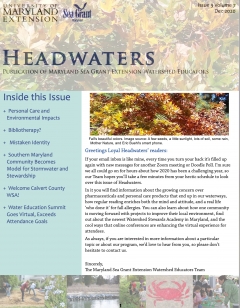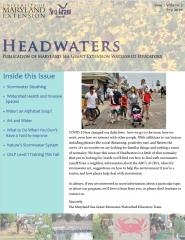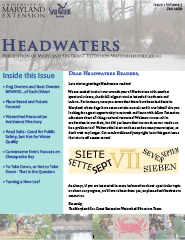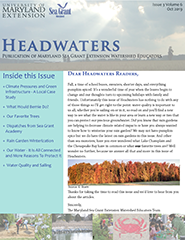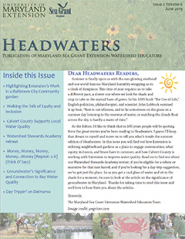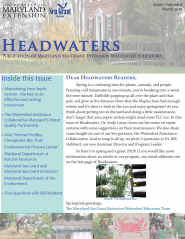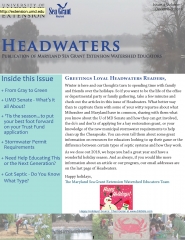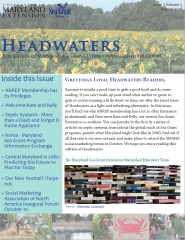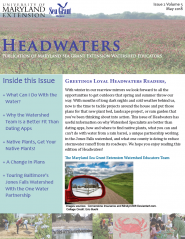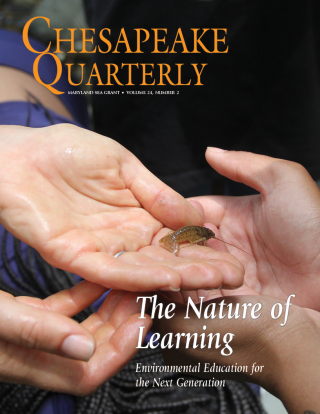Knauss legislative fellowships in Congress help build careers — and they're fun and educational. See our video and fact sheet for details.
Headwaters Newsletter
Headwaters is a publication that provides information and resources for Extension and watershed protection professionals. It is produced by watershed educators from the University of Maryland Extension and Maryland Sea Grant Program. If you have comments, questions, or ideas for Headwaters, contact one of the specialists listed below. (Learn more about the services they offer.)
To subscribe to Headwaters, email any of the watershed specialists, and we'll put you on the list.
Watershed Restoration Specialists
- Eric Buehl, ebuehl@umd.edu (Mid and Upper Eastern Shore)
- Jennifer Dindinger, jdinding@umd.edu (Lower Eastern Shore)
- Amanda Rockler, arockler@umd.edu (Central Maryland)
- Jacqueline Takacs, takacs@mdsg.umd.edu (Southern Maryland)
Volume 8, Issue 1 /
In this Issue:
- Anywhere it Rains, it can Flood
- Helpful Resources to Support Homeowners Planting Trees
- Getting Ready for Spring
- Could Your Home's Water Use Some Spring Cleaning?
- First Sign of Spring
- Spring Greening with Trees
Volume 7, Issue 3 /
In this Issue:
- Personal Care and Environmental Impacts
- Bibliotherapy?
- Mistaken Identity
- Southern Maryland Community Becomes Model for Stormwater and Stewardship
- Welcome Calvert County WSA!
- Water Education Summit Goes Virtual, Exceeds Attendance Goals
Volume 7, Issue 2 /
In this Issue:
- Stormwater Sleuthing
- Watershed Health and Invasive Species
- Water: an Alphabet Soup?
- Art and Water
- What to Do When You Don't Have a Yard to Improve
- Nature's Stormwater System
- CBLP Level 1 Training This Fall
Volume 7, Issue 1 /
In this Issue:
- Dog Owners and Boat Owners BEWARE . . . of Each Other!
- Place-Based and Future Focused
- Watershed Restoration Assistance Directory
- Road Salts—Good for Public Safety, but Not for Water Quality
- Cornerstone Event Focuses on Chesapeake Bay
- To Take Down, or Not to Take Down—That Is the Question
- Turning a New Leaf
Volume 6, Issue 3 /
In this Issue:
- Climate Pressures and Green Infrastructure — A Local Case Study
- What Would Bernie Do?
- Our Favorite Trees
- Dispatches from Sea Grant Academy
- Rain Garden Winterization
- Our Water — It Is All Connected and More Reasons To Protect It
- Water Quality and Sailing
Volume 6, Issue 2 /
In this Issue:
- Highlighting Extension’s Work in a Baltimore City Community garden
- Walking the Talk of Equity and Inclusion
- Calvert County Supports Local Water Quality
- Watershed Stewards Academy retreat
- Money, Money, Money, Money...Money [Repeat: x 6] (think O’Jays)
- Groundwater’s Significance and Connection to Bay Water Quality
- Day Trippin’ on Delmarva
Volume 6, Issue 1 /
In this Issue:
- Maintaining Your Septic System — the Key to an Effective and Lasting Investment
- The Watershed Assistance Collaborative — Maryland’s Water Quality Partnership
- WAC Partner Profiles: Chesapeake Bay Trust, Environmental Finance Center, Maryland Department of Natural Resources, Maryland Sea Grant and Maryland Sea Grant Extension, Maryland Department of the Environment
- Five Questions with Bill Hubbard
Volume 5, Issue 4 /
In this Issue:
- From Gray to Green
- UMD Senate — what’s it all About?
- ‘Tis the season . . . to put your best foot forward on your Trust Fund application
- Stormwater Permit Requirements
- Need Help Educating This or the Next Generation?
- Got Septic - Do You Know What Type?
Volume 5, Issue 3 /
In this Issue:
- ANREP Membership has its Privileges
- Welcome Kate and Kelly
- Septic Systems — More than a Flush and Forget it Home Appliance
- Korea — Maryland Sea Grant Program Information Exchange
- Central Maryland in 2080: Predicting the Future to Plan for Today
- Our New Normal? I hope not
- Social Marketing Association of North America Inaugural Forum October 10
Volume 5, Issue 2 /
In this Issue:
- What Can I Do With the Water?
- Why the Watershed Team Is a Better Fit Than Dating Apps
- Native Plants, Get Your Native Plants!
- A Change In Plans
- Touring Baltimore’s Jones Falls Watershed With the One Water Partnership

